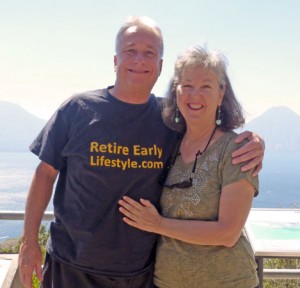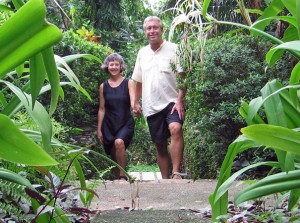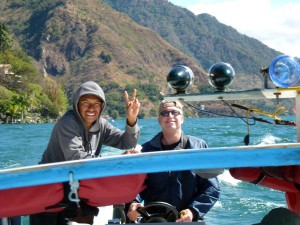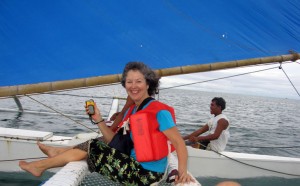
By Billy and Akaisha Kaderli
Special to the Financial Independence Hub
In January we began our 25th year of Financial Independence. Few people can say they have 24 years of self-funded retirement by age of 62, and have a higher net worth after spending and inflation than when they started. This is something of which we are quite proud.
As we have aged one thing we have learned is that the long term is getting shorter every day. Life is to be enjoyed now, not someday – the older we get, the more we appreciate that view. Life is continuously full of opportunities and we want to take them.
Opportunities abound
 For example, last year we were approached by a startup company that sponsored us for several months in Saigon, Vietnam. In exchange we shared our past experience in the restaurant and service industry and received exposure to our readers through our popular website and blog. That was a fabulous trip, and it got us back over to Asia again.
For example, last year we were approached by a startup company that sponsored us for several months in Saigon, Vietnam. In exchange we shared our past experience in the restaurant and service industry and received exposure to our readers through our popular website and blog. That was a fabulous trip, and it got us back over to Asia again.
Then we were approached to start offering tours to Europe and South America, but we haven’t made any decisions on that project just yet.
These are just two examples of why we say life is full of opportunities if you want to take them. And neither of these recent options could have been presented to us if we were still working.
Portfolio Getting Stronger
The last couple of years of double-digit growth in the markets certainly increased the value of our portfolio. And for a longer-term view, the S&P 500 closed at 312.49 when we retired in 1991, producing a better than 8% annual ride plus dividends. So our advice is to get invested now and in a couple of decades looking back you will have wished you had invested more. Probably a lot more.
We suggest people track their spending now, then multiply that number by 25 to get a rough estimate of the portfolio amount they’ll need to retire. Once you know that amount, in simple terms, assuming the same 8% growth in the future and withdrawing 4% for living expenses, this leaves you 4% to cover inflation and growth, so you are all set.
The 4% rule is a guide not set in stone. Ours bounces around depending on the markets and our expenses, but on average we have been able to maintain it easily below 4%. Our data over 24 years gives us security, knowing that if one year it is higher we can make adjustments the following year to correct it. Then again the markets could move higher, helping us out as well, which is usually the case. Plus we now are receiving our first year of social security, so payments and dividends cover our expenses. You can read our reasoning behind this decision here.
Practical considerations
Another note is that because we have a good percentage of assets in retirement accounts, when we turned 56 years old we used IRS rule 72T to withdrawal an annual amount close to our estimated Social Security payments, thus creating a bridge until we actually qualified. Now that we are receiving benefits we have turned off that spigot and are letting the IRAs grow once again.
The age of 70 is now coming into our sight and RMD, required minimum distributions, are the next issue to deal with, but we still have time and no one knows what the tax laws will be in eight years.
With that stated, we still maintain a core holding of buy and hold (DVY, SPY, VTI) which sends us a steady stream of dividends in our taxable accounts as well as tracking the market. But in our IRAs, where we have no tax issues regarding trading, we have been more active, using market seasonality with the idea of side-stepping larger declines. Some years have been better than others but we have been taking about half the market risk than being all-in all the time and that is comforting.
Where to retire, cost of living and healthcare
 We’re no longer alone anymore — with Boomers retiring at a rate of 10,000 a day, we see more retirees everywhere! But in terms of the foreign locations that we visit, the retirement community of Chapala, Mexico is growing at a fast pace. The Colonial town of Antigua, Guatemala has also attracted its share of Expats, and there is a solid and active retirement community in Chiang Mai, Thailand.
We’re no longer alone anymore — with Boomers retiring at a rate of 10,000 a day, we see more retirees everywhere! But in terms of the foreign locations that we visit, the retirement community of Chapala, Mexico is growing at a fast pace. The Colonial town of Antigua, Guatemala has also attracted its share of Expats, and there is a solid and active retirement community in Chiang Mai, Thailand.
We would recommend Mexico and Guatemala for their proximity to the U.S. as well as being in similar time zones as family and financial markets in the States. We would say Thailand is attractive for its excellent medical care, warmer weather and uniqueness. All three of these locations offer excellent lifestyle for cost of living.
The longer we are perfecting our skills, the cost of living doesn’t seem to pose much challenge and we continue to live on less than $30,000 annually without a struggle.
Regarding healthcare outside the States, in 2012, Akaisha almost lost her ring finger on her right hand in a de-gloving accident. We were in Antigua, Guatemala at the time, and in an instant, were facing a severe health incident. First we got her to a state-run hospital and the doctors there took care of the bleeding and wrapped her up. Then, two days later we got a hold of the Guatemala City head of plastic surgery, who took over all the procedures and prescribed hyperbaric chamber treatments, saving her finger.
We are still quite impressed with our experiences in Medical Tourism wherever we have needed them, finding qualified doctors with modern equipment. As a matter of fact we just finished receiving full physicals, colonoscopies and dental work in Thailand, where there is some of the best health care on the planet.
At this time we are still self-insured, paying out of pocket for services needed and when we travel to the States, we take out travellers insurance.
Is it dangerous to travel overseas?
Security is always an issue regardless of being in the States or in another country. It has been our experience that people are friendly everywhere and for the most part want the same things as we do – to live in peace, raise their families, make a decent living, and to share with others. This is not to say some cities are not dangerous and one must use common sense in navigating around. But we have dangerous locations in the States as well, with drive-by shootings, robberies and untoward behavior.
Yes, there are some cultural differences with which one must contend when living abroad, and from our observation, that poses more of a day-to-day challenge to Expats than the safety factor.
Misconceptions
Probably the biggest misconception about retiring early is that it cannot be done successfully; that we would run out of money, be socially isolated and bored or that we would have to deprive ourselves of luxury in order to manage an early retirement. Our last 24 years of self-funded retirement and travel has proven those concerns to be overstated. But then we are disciplined in tracking our spending and assertive in managing our Cost per Day average.
The biggest incorrect idea about retiring abroad is that one can avoid paying U.S. taxes. But, being U.S. citizens, we pay taxes no matter what our location.
As we mentioned above, investing early and with as much as you can is key. Then let the market do the work for you, increasing your wealth. For younger readers, time is your biggest asset and something not to be squandered. Get started now.
We employ the K.I.S.S. method (Keep It Simple Stupid) for most of what we do. The way we manage our retirement remains simple; Track our spending, manage our Cost per Day. This can be done with paper and pencil.
Of course we follow the market, trade low-cost ETFs and keep abreast of the news all via the internet. But in our opinion, one does not need to get fancy to accomplish a satisfying retirement.
The biggest concerns or sources of anxiety we have
Of all the things that could possibly keep us up at night, our biggest source of anxiety is the death of a spouse. We are not 38 anymore, with the idea that death is at bay. All four of our parents are gone and in the last five years we have lost many friends. To be single again and without our best friend at the age of 60 or beyond is disconcerting. Facing one’s demise is Life’s ultimate challenge, one that is not singular to us. It brings us to the viewpoint that Life and Love are to be enjoyed now, while we can.
In terms of other practical concerns, getting help with assisted living, end-of-life care and such, is far more affordable overseas than it is in the States.
We have always taken the attitude that if we could retire early, you could too. We encourage you to stay on course for the lifestyle you desire, and never, ever, let anyone steal your dreams.
About the Authors
Billy and Akaisha Kaderli are recognized retirement experts and internationally published authors on topics of finance and world travel. With the wealth of information they share on their popular website RetireEarlyLifestyle.com, they have been helping people achieve their own retirement dreams since 1991. They wrote the popular books, The Adventurer’s Guide to Early Retirement and Your Retirement Dream IS Possible.



I wish I had read articles like this about 10 yrs ago. I would have probably bailed on my corporate job much earlier and wouldn’t need the high blood pressure pills I’m currently on. Totally agree with the line ‘Life is full of opportunities if you want to take them.” These are great role models the only question I have is are they really retired? They have created a great lifestyle but it looks look they make some income via their blog/website and books that they write. So again are they really retired or have they just created a customized life style that is really appealing but also includes some element of work, work that is enjoyable but still work nonetheless..